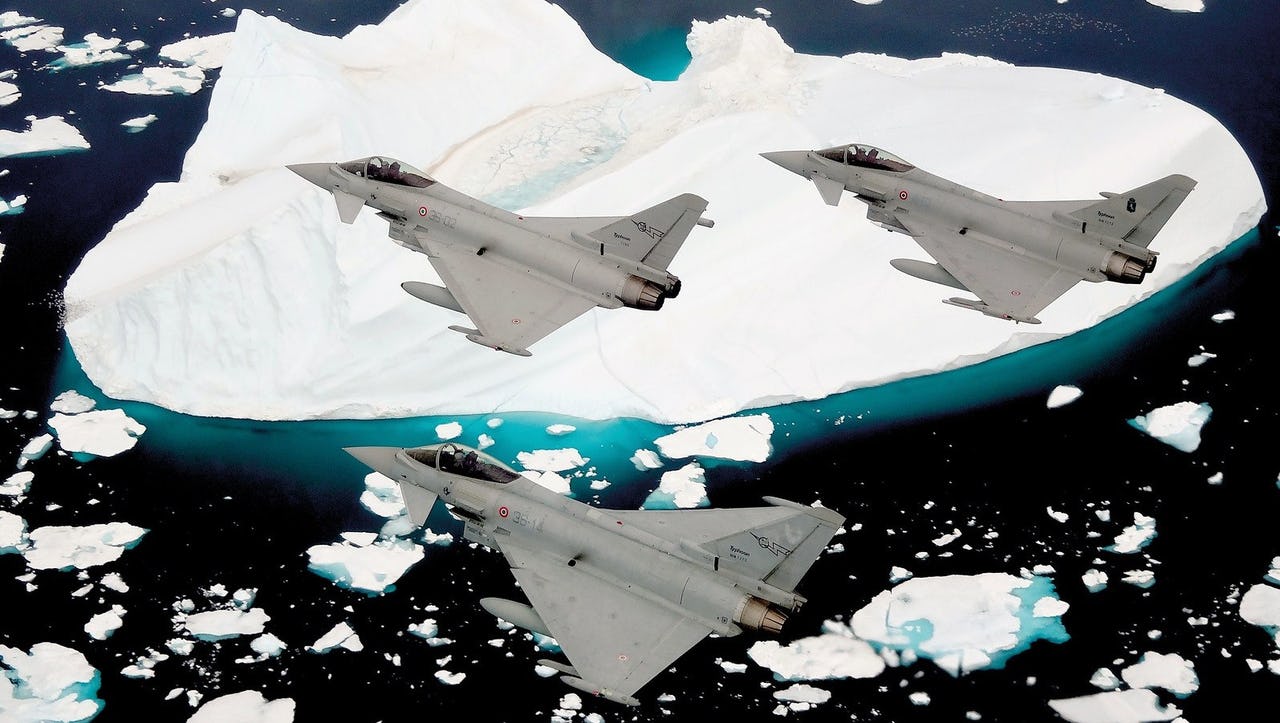
Italian military aircraft support a NATO mission over Iceland. Photo: Robert Sullivan
On 16 March 2021, the United States Army published its new Arctic strategy. Titled Regaining Arctic Dominance, the document states that the Army must “organize to win in the Arctic,” and that the region represents “an arena of competition, a line of attack in conflict, a vital area holding many … natural resources, and a platform for global power projection.” The US Army strategy follows similar publications from the Government of Canada, the Norwegian military, the United States Navy, and a host of other Arctic and non-Arctic state institutions committed to increased military engagement in the circumpolar north. And these ambitious new Arctic security policies are more than just saber-rattling: NATO doubled Arctic military activities from 2015 to 2020 and Russia has assigned at least 81% of its nuclear weaponry to northern fleets, all in the name of (re)gaining Arctic dominance.
As noted in the US Army strategy, the contemporary militarization of the Arctic region is driven by a number of factors. First, as sea ice and permafrost melt away due to climate change, lucrative Arctic resources such as oil and gas, minerals, and fish stocks become increasing accessible – and occasionally disputed as nations contest territorial boundaries and the policies that delineate them. Second, Arctic and subarctic territories represent strategic points for transportation, information and intelligence gathering, military operations, and a number of other activities associated with state economic and defense priorities. And finally, as Arctic interests such as natural resources and transportation routes have become tied to national growth, capability, and strategy, the circumpolar north has emerged as a region of interstate competition. A changing Arctic therefore represents a region of new opportunities and shifting priorities for stakeholder nations who increasingly deploy military resources to obtain or defend Arctic interests, both via direct deterrence and the broader projection of regional power.
This growing militarization and competition in the Arctic has raised concerns surrounding the potential for conflict in the region, which may be particularly devastating in fragile polar environments. Questions have been asked about how Arctic conflict might be predicted and whether such wars could be prevented. Yet our responses to such questions need not be purely speculative or theoretical: The Arctic region has a rich history of militarization and military conflict. The proceeding four-part series – to be published throughout May and June 2021 – provides historical analyses of past Arctic conflict. Through these analyses, we explore the role that northern territories have played in conflict and how this history informs contemporary matters related to militarization and peacebuilding in the circumpolar north.
A brief history of Arctic conflict
Religious conflict and colonial violence contributed to the establishment of the eight modern Arctic states: Canada, the United States, Iceland, Norway, Denmark, Sweden, Finland, and Russia. Early interstate conflict between Arctic nations – including Canada and the US and Norway and Sweden – further influenced the foundation of modern Arctic relations. As will be discussed in Evans and Østhagen’s forthcoming article, Fisheries Disputes: The real potential for Arctic conflict, some of the earliest interstate conflicts among Arctic stakeholders involved the delineation and management of natural resources such as seal and fish stocks.
Arctic resources continued to play a critical role in national strategies into the twentieth century. By the time World War II began in 1939, Germany was dependent on Sweden for over 50% of its iron ore – an element critical to German military and economic capability – and was further dependent on Norway for transit of Swedish minerals to Germany.1) In their upcoming article, Knowledge is Power: Greenland, Great Powers, and Lessons from the Second World War, Rogers and Gjerstad analyze the strategic role that Greenland played in providing a different kind of resource to forces in World War II: information, which was used in the planning of military operations on the European continent.2)
The Arctic remained a pivotal military theater throughout the Cold War. During this period, the Arctic was characterized by high levels of militarization, which included the regional placement of intercontinental ballistic missiles (ICBMs), long-range bombers, nuclear weapons, and a host of additional military resources. Despite such militarization, potential for Cold War Arctic conflict was mitigated via a number of mechanisms, two of which will be explored in this series. First, Teeple’s article, The Impact of the Post-Arms Control Context and Great Power Competition in the Arctic, looks at the destabilizing effect of Cold War militarization and how this destabilization led to international cooperation on arms control. Second, Devyatkin’s article, Environmental Détente: What can we learn from the Cold War to manage today’s Arctic tensions and climate crisis?, explores the influence of bilateral cooperation in Arctic science on broader US-Soviet diplomacy.
Looking forward in Arctic diplomacy
The articles featured in this series not only investigate the past, but also interrogate the future. As fisheries stocks move north due to warming ocean temperatures, what are the potentials for new – or renewed – resource conflict in the Arctic? How will contemporary Arctic competition – including great-power competition – manifest in the context of a strategically valuable Greenland? What paths might Arctic militarization take in the post-arms control context, after the events of 9/11 revealed American vulnerabilities to modern large-scale threats? And how can growing military tensions in the Arctic be mitigated using past strategies for diplomacy and de-escalation? The forthcoming series ultimately provides useful analysis of current and potential future risks for military conflict in the Arctic regions, as well as lessons learned for the mitigation or resolution of such conflicts.
"conflict" - Google News
May 25, 2021 at 01:20PM
https://ift.tt/3oYLYA1
The History and Future of Arctic State Conflict: The Arctic Institute Conflict Series - The Arctic Institute
"conflict" - Google News
https://ift.tt/3bZ36xX
https://ift.tt/3aYn0I8
Bagikan Berita Ini














0 Response to "The History and Future of Arctic State Conflict: The Arctic Institute Conflict Series - The Arctic Institute"
Post a Comment